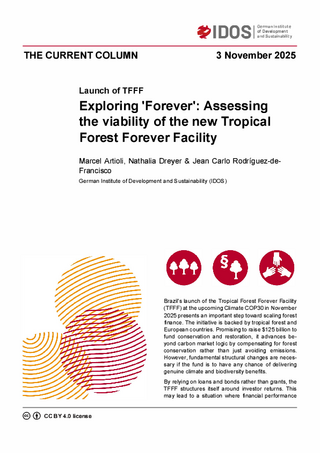Launch of TFFF
Exploring 'Forever': Assessing the viability of the new Tropical Forest Forever Facility
Artioli, Marcel / Nathalia Dreyer / Jean Carlo Rodríguez-de-FranciscoThe Current Column (2025)
Bonn: German Institute of Development and Sustainability (IDOS), The Current Column of 3 November 2025
Brazil's launch of the Tropical Forest Forever Facility (TFFF) at the upcoming Climate COP30 in November 2025 presents an important step toward scaling forest finance. The initiative is backed by tropical forest and European countries. Promising to raise $125 billion to fund conservation and restoration, it advances beyond carbon market logic by compensating for forest conservation rather than just avoiding emissions. However, fundamental structural changes are necessary if the fund is to have any chance of delivering genuine climate and biodiversity benefits.
By relying on loans and bonds rather than grants, the TFFF structures itself around investor returns. This may lead to a situation where financial performance takes priority over conservation, biodiversity, climate and equity outcomes. The fund should establish clear return caps to ensure that investor profits do not compromise conservation goals. In addition, it should create transparency mechanisms showing how investor returns correlate with forest protection and equity outcomes. Ring-fencing a percentage of resources as pure grants would be another mechanism to avoid compromising the goals of the initiative.
The proposed US$4 per hectare annual payments underestimate forests' ecological contribution in terms of carbon sequestration, water regulation, and biodiversity. Instead, regional payment tiers should reflect actual deforestation pressures and regional variation in opportunity costs, with valuations updated regularly as commodity prices change. Critically, payments alone cannot stop deforestation without addressing the systemic issues: agricultural subsidies that incentivize clearing, lacking legal recognition of Indigenous and Traditional Territories (ITTs), and trade agreements that reward extraction over conservation. Furthermore, the facility must explicitly exclude investments that target the primary economic sectors driving deforestation—cattle ranching, crops, and mining. An overly economic approach risks reducing forests to financial assets subject to market volatility, while leaving the underlying political economy of deforestation untouched. Complementary structural modifications of public policies are essential: eliminating perverse subsidies, implementing stronger regulations on commodity supply chains, and shifting trade agreements that incentivize forest destruction.
Addressing other factors is essential for the initiative's success. Verification should be strengthened by combining satellite data with on-the-ground independent verification, establishing clear baselines and measurement protocols, periodic external audits, and real-time public monitoring dashboards. While the fund allocates a minimum of 20% to Indigenous People and Local Communities (IP&LCs)—recognized as the most successful forest stewards—this floor risks becoming a ceiling without direct-access mechanisms and transparent accounting. National governments currently remain primary payment recipients, creating risks of political capture and financial leakage. Direct-access windows for IP&LCs organizations, ring-fenced accounts with regular public reporting of transfers and execution, and separate governance tracks for IP&LC-managed territories are essential safeguards. Monitoring frameworks should couple canopy and degradation metrics with distributional and rights indicators: direct IP&LCs share of payments, transfer transparency and timeliness, the recognition of ITTs, and free, prior and informed consent processes, reported publicly on a regular basis.
Strengthening the TFFF requires close alignment with Paris Agreement Article 2.1(c), which mandates that forest finance prioritize forest and community welfare over investor returns, ensuring climate and biodiversity imperatives drive decision-making. This requires establishing clear legal commitments to conservation outcomes, governance boards with majority representation from tropical forest countries and IP&LCs, and impact assessment frameworks measuring climate, biodiversity, and equity as primary success goals. Beyond adapting the design of the TFFF itself, complementary measures are essential to mobilize resources and address deforestation's root causes: stronger regulations on deforestation-linked exports and foreign debt cancellation for forest nations can mobilize substantial resources for Conservation Basic Income.
Progress in forest governance requires decisively shifting resources and power to those who protect forests on the ground while confronting deforestation's structural drivers. If it succeeds in aligning global finance with climate imperatives and IP&LCs’ rights, the TFFF could catalyze meaningful transformation. But this requires moving beyond a finance-first logic, implementing a governance structure that focuses on forest defenders and IP&LCs as agents of change while addressing the political economy of deforestation.
Marcel Artioli is a visiting researcher in the field of environmental governance at IDOS. He is a PhD candidate at Scuola Normale Superiore in Florence.
Nathalia Dreyer is a fellow of the Managing Global Governance (MGG) Academy 2025 at IDOS. She is a PhD candidate at the Federal University of Rio de Janeiro.
Jean Carlo Rodríguez-de-Francisco is a senior researcher in the Environmental Governance research department at IDOS.


